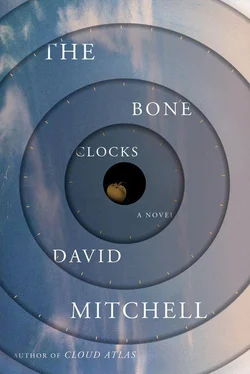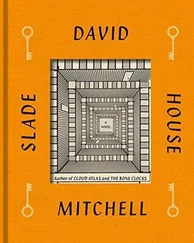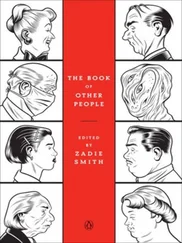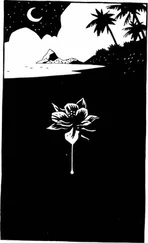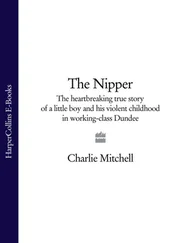A SHOEBOX-SIZED PARCEL forwarded by Sadaqat is waiting on the kitchen table, but I haven’t eaten all day, so I put it aside and microwave a dish of stuffed aubergines prepared by my once-a-week housekeeper, Mrs. Tavistock. I crank up the heating. The snow’s all melted but it doesn’t yet feel like spring. I wash down my supper with a glass of rioja, and read an article in the Korean Psychiatric Journal . Only then do I remember the parcel. The sender is one Åge Næss-Ødegård from a school for the deaf in Trondheim, Norway, a country I haven’t visited since I was Klara Koskov. I take the parcel into my study to check it with a handheld explosives detector. The LED stays green, so I remove the two outer skins of brown paper. Inside is a sturdy cardboard box, containing a cocoon of bubble wrap enclosing a second box crafted from mahogany. I lift its hinged lid to find a Ziplock plastic bag containing a Sony Walkman of a chunky 1980s design. Plugged into it is a set of earphones made of metal, plastic, and foam. The Walkman contains a C30 BASF cassette, a brand whose very existence I had forgotten. After deploying the explosives detector on the Walkman, I read the three-page letter that was also stowed in the mahogany box:
Øvre Fjellberg Skole for Døve
Gransveien 13,
7032 TRONDHEIM
Norge/Norway
15 March 2025
Dear “Marinus,”
First, I beg your pardon. I don’t know if “Marinus” is Mr. or Mrs. or Doctor, your family name or your given name. Pardon also my poor English. My name is Åge Næss-Ødegård. Maybe Mrs. Esther Little told you my name, but in this letter, I will assume she did not. I am a seventy-four-year-old Norwegian man who lives in Trondheim, a town of my native Norway. In case you don’t know why a stranger is sending you an old audio machine, here is the full story.
My father established the Øvre Fjellberg School in 1932, because his brother Martin was born with deafness and, in those days, attitudes were primitive. I was born in 1950 and I could sign fluently (in Norwegian, of course) before I was ten. My mother managed the office of Øvre Fjellberg School and my uncle Martin became the groundsman, so, you can imagine, our school and its students were the life of our family. I graduated from Oslo University in 1975 with a degree in education, and I returned to Trondheim to teach at Øvre Fjellberg. I established a Music and Drama Department here, because also I love the violin. Many nondeaf people do not guess that deaf people can enjoy music in various ways, so it was our school’s tradition to work with our local amateur orchestra to produce a spring concert for an audience of both deaf and nondeaf people. Signing, dance, amplification, images, and so on are used. In 1984, when this story happened, I chose Jean Sibelius’s “The Swan of Tuenola” for our annual performance. It is very beautiful. Perhaps you know?
Anyway in 1984, we had one dark cloud above our landscape (do you say this in English?). Namely, the financial position of our school was critical. Øvre Fjellberg is a charitable foundation but we required a big subsidy from Oslo to pay for salaries, and so on. I will not bore you with old politics, but the national government at that time cut our subsidy, to oblige our students to attend another school, two hours away by car. We protested the decision, but without financial independence or political muscle, our precious school was to be shut, after half a century of excellent work. For our family, this was a tragedy.
However, one day in June of 1984, I received a visitor in my office. She was in her fifties, perhaps. She had short gray hair and masculine clothes and a face of many stories. She apologized for disturbing me in foreigner’s Norwegian, then asked if we could speak English. I said yes. She said her name was Esther Little. Esther Little had attended our students’ recent concert and enjoyed it greatly. She had also heard of the school’s bad financial position, and she wished to assist, if possible. I said, “If you have a magic wand, please, I am listening.” Esther Little put a wooden box on my desk. This is the mahogany box I send to you. Inside was a portable cassette player and one cassette tape. Then Esther Little explained this deal. If I keep these items for some years, and then post it to her friend “Marinus” at an address in New York, she would tell her lawyers in Oslo to make a large donation to our school.
Should I agree? Esther Little read my thoughts. She said, “No, I am not a drug lord, or a terrorist, or a spy. I am an eccentric philanthropist from Western Australia. The cassette is a message to a friend, Marinus, who will need to hear it when the time is right.” As I write this letter today, I don’t know why I believed her, but sometimes you meet people who you believe. It is an instinct. I believed Esther Little. Her Oslo lawyers were a respectable conservative firm, so perhaps this influenced my decision. I asked, why not did she simply pay her Oslo lawyers to post her box to New York on a certain date in the future? Esther Little said, “Lawyers come and go. Even discreet ones are visible, and they all work for money. But you are an honest man in a quiet corner of the world, and you will live a long time.” Finally, she wrote down the donation she offered. I am sure my face became pale like a ghost when I saw the number on the sheet of paper! Our school would be safe for five years, at least. Esther Little said, “Tell your board of governors that the money was donated from a wealthy anonymous donor who believes in the work of Øvre Fjellberg School. This is the truth.” The box and our deal should be our small secret, is what I understood.
We shook hands. Naturally, my last question was, “When do I post the box to ‘Marinus’ in Manhattan?” Esther Little took a small porcelain statue of Sibelius from a box, put it on a high bookshelf, and said this: On the day Sibelius was smashed into many pieces, that day I must post the box. I thought I had not understood her English, so I examined her request carefully. If the statue broke next week, I must post the box next week. If it broke in year 2000, I must post the box in year 2000. If I die before the statue breaks, then I never post the box. Yes, that was the deal, said Esther Little. “Like I said, I am eccentric,” she said. We said goodbye and, to be honest, when she was gone I wondered if I dreamed her. But next day, the lawyer telephoned from Oslo for our bank account number, and every krone Esther Little promised was transferred. Øvre Fjellberg was safed. Three or four years later, the government ideas changed greatly and big investment was made for our school, but there is no doubt, Mrs. Esther Little rescued us at our worst time. In 2004, I became principal, and I retired a few years ago but I am still a governor, and even today, I use my former office as a study. All those years, Jean Sibelius watched my office, like a man who knows the secret.
You can guess the ending, I think. Yesterday was the first mild day of spring. Like most people in Norway, I opened the window for make air fresh in my office. Students was playing on tennis courts below my window. I left my study to make my morning coffee. I heard a noise. When I returned, Jean Sibelius was on the floor. His chest and head was in many little pieces. There was a tennis ball near. The chance was 10,000 of 1, but the time came. So I am sending the box, as I promised, with this strange story. I hope the message on the cassette is clear after forty years, but I never listened it. If Mrs. Little is still walking this world (if so, surely she is over 100 years old), give her thanks and regards from an honest man in a quiet corner of the world who has lived a long time indeed.
Sincerely,
Åge Næss-Ødegård
My heart is sprinting with no sign of a finishing line. A hoax? I get my slate and shirabu “Øvre Fjellberg Skole for Døve”: There it is. A fake website? Possibly, but the Sibelius statue and the Norwegian backwater both smack strongly of Esther Little. If she was planting this marker in June of 1984, she was reacting to glimpses of the Script. If the First Mission was Scripted, then maybe, maybe, it was not the crippling defeat that we’ve believed it was for the last forty-one years. Yet how could the deaths of Xi Lo, Holokai, and Esther Little be part of a bigger scheme? Luckily I have some AA batteries in my desk drawer — they are also nearly extinct — and slot them into the Walkman. Will they still have any juice in them? I plug in the earphones, hesitate, and press play. The spindles rotate. There are a few seconds of silent “header,” then magnetic hiss, then a clunk where the recording begins. I hear a distant motorbike, and a familiar voice whose timbre and croak make my breath catch and my heart ache for my long-lost friend.
Читать дальше
